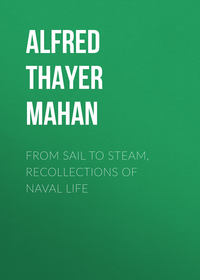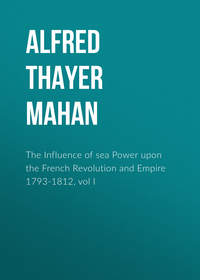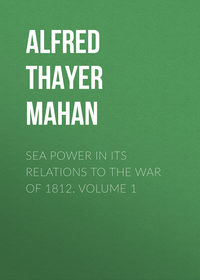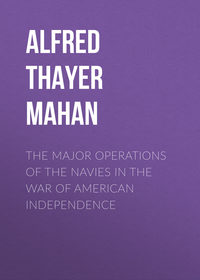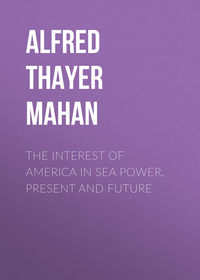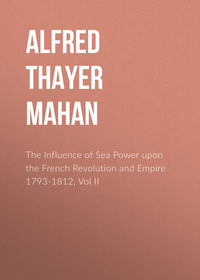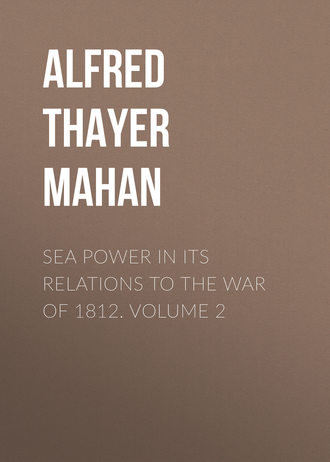 полная версия
полная версияSea Power in its Relations to the War of 1812. Volume 2
34
Naval Chronicle, vol. xxix. p. 497. The following extract from an American journal may have interest as indicating the extent of the British convoy movement. "American brig 'Hazard,' arrived at New York from Madeira, June 5, reports: 'April 11, arrived at Funchal the outward bound East India and Brazil fleets, forty sail, under convoy. Sailed April 12. April 21, arrived outward bound Cork fleet, one hundred and eighty sail convoyed by a seventy-four, a frigate, and a sloop.' April 30, sailed from Jamaica, three hundred merchantmen, under convoy of a seventy-four, two frigates and a sloop." (Columbian Centinel, of Boston, June 9, 1813.)
35
Murdoch's History of Nova Scotia, vol. iii. p. 351.
36
Captains' Letters, April 13, 1813.
37
Ibid., May 22.
38
Niles' Register, vol. iv. p. 134.
39
Letter of Governor Winder, April 26, 1813. Niles' Register, vol. iv. p. 204.
40
Yeo to Croker, May 26, 1813. Admiralty In-Letters, Records Office.
41
Captains' Letters, Navy Department.
42
American State Papers, Military Affairs, vol. i. p. 439.
43
Between July, 1812, and March 25, 1813, Prevost received re-enforcements amounting in all to 2,175 regulars. His total force then, for all Canada, excluding militia, was 9,177; of which 2,000 were provincial corps. British Records Office.
44
American State Papers, Military Affairs, vol. i. p. 441.
45
Chauncey to Navy Department, March 8, 12, and 16, 1813. Captains' Letters.
46
American State Papers, Military Affairs, vol. i. p. 442.
47
Captains' Letters.
48
Captains' Letters, Nov. 5, 1814.
49
Captains' Letters, May 7, 1813.
50
Ibid., May 15.
51
Canadian Archives. C. 678, p. 332.
52
American State Papers, Military Affairs, vol. i. p. 445.
53
Ibid., p. 449. Armstrong's italics.
54
Barclay's Narrative before the British Court Martial on the Battle of Lake Erie. British Records Office.
55
Prevost to Bathurst, Canadian Archives.
56
Mackenzie's Life of Perry, vol. i. p. 148.
57
Barclay's Narrative.
58
Brown's and Prevost's Reports of this affair may be found in Niles' Register, vol. iv. pp. 260, 261. That of Yeo is in the Canadian Archives; M. 389, 6, p. 22.
59
Captains' Letters, June 11, 1813.
60
Captains' Letters.
61
The account of these transactions is summarized from American State Papers, Military Affairs, vol. i. pp. 445-449. For Vincent's report of the Stony Creek affair see Cruikshank's Documentary History of the Campaign on the Niagara Frontier, 1813, Part II, p. 8.
62
Smyth's Précis of Wars in Canada, p. 137.
63
Scott's Memoirs, vol. i. p. 94.
64
American State Papers, Military Affairs, vol. i. pp. 450, 451.
65
Formerly the "Prince Regent."
66
Yeo's Report of the Vessels on the Lakes, July 15, 1813. British Records Office.
67
Woolsey to Chauncey, June 20 and 21, 1813. Captains' Letters.
68
Chauncey to the Department, July 5, 1813. Captains' Letters.
69
Captains' Letters. Navy Department MSS.
70
"History of the Royal Navy," edited by Sir W.L. Clowes, vol. iii. p. 411.
71
That is,—row
72
Chauncey's Report of this cruise is in Captains' Letters, Aug. 13, 1813. Also, in Niles' Register, vol. iv. p. 421.
73
James, Naval Occurrences. Appendix, p. lxxiv.
74
Captains' Letters, Navy Department MSS.
75
Mackenzie's Life of Perry, vol. i. p. 166.
76
Mackenzie's Life of Perry, vol. i. p. 186.
77
Perry to the Secretary of the Navy, Aug. 10, 1813. Mackenzie's Life of Perry, vol. i. p. 191.
78
Secretary's Letters, Aug. 18, 1813. Navy Department MSS.
79
Otherwise known by the name of the River Raisin. Ante, vol. i. p. 370.
80
The data of this paragraph are taken from the Report on Canadian Archives, 1896, Lower Canada, pp. 132, 138-140. Barclay in his Defence before the Court Martial mentions the designs on Erie.
81
Harm Jan Huidekoper, by Nina Moore Tiffany and Francis Tiffany. 1904. p. 187. Mr. Huidekoper speaks admiringly of the unfaltering composure and cheerfulness which under these circumstances accompanied Perry's energy.
82
See ante, p. 41.
83
Report on Canadian Archives, 1896. Lower Canada, p. 133.
84
This statement appeared in the course of a summary of the evidence before the British Court, given by the Naval Chronicle, vol. xxxii. pp. 241-242. The only support to it in the evidence, as recorded, is Barclay's official letter, which he appears to have confirmed under oath, that the "Niagara" kept out of carronade range, and "was perfectly fresh at 2.30," when Perry went on board her. The first lieutenant of the "Queen Charlotte," who remained in command, the captain being killed, corroborated Barclay as to her distance.
85
In the finding—or verdict—of the British Court, as in the evidence, there is no expression of a charge that the "Niagara" was making away. The finding restricted itself to the matter before the Court, namely, Barclay's official conduct.
86
There was a question whether the "Hunter" was ahead or astern of the "Queen Charlotte." In the author's opinion the balance of evidence is as stated in the text. Perry rearranged his line with reference to the British, upon seeing their array. Had the "Charlotte" been next the "Detroit," as James puts her, it seems probable he would have placed the "Niagara" next the "Lawrence."
87
Cooper, Battle of Lake Erie, p. 63.
88
See Mackenzie's Life of Perry, 5th edition, vol. ii. pp. 251-252. Perry's charges against Elliott, dated Aug. 8, 1818, are there given in full.
89
See Mackenzie's Life of Perry, 5th edition, vol. ii. pp. 251-252.
90
Cooper's Battle of Lake Erie, p. 63.
91
Barclay's Report, Naval Chronicle, vol. xxxi. p. 251.
92
The range of a 32 pdr. carronade, with which the "Niagara" was armed, throwing one solid shot, with ¼ degree elevation,—substantially point-blank,—was 260 yards; at 5 degrees, 1260 yards. The difference, 1000 yards, is just half a sea mile. A British professional writer of that day, criticising their commander's choice of position at Lake Champlain, says: "At 1000 or 1100 yards the elevation necessary to be given a carronade would have been so great that none but chance shots [from the Americans] could have taken effect; whereas, in closing, he gave up this advantage." Naval Chronicle, vol. xxxiii. p. 132.
93
The "Caledonia" had two long 24-pounders, and one other lighter gun, variously stated. The "Detroit's" heaviest were also two long 24's; she had besides one long 18, six long 12's, etc.
94
With reference to times, always very difficult to establish, and often very important as bases of calculation, the following extract from the Diary of Dr. Usher Parsons, surgeon of the "Lawrence," possesses value; the more so as it is believed to have been copied from the log of the vessel, which afterwards disappeared. The phraseology is that of a log and a seaman, not of a physician. "At 10 called all hands to quarters. A quarter before meridian the enemy began action at one mile distance. In a half hour came within musket-shot of the enemy's new ship.... At 1.30, so entirely disabled we could work the brig no longer. At 2 P.M., most of the guns were dismounted, breechings gone, or carriages knocked to pieces. At half-past two, when not another gun could be worked or fired, Captain Perry hauled down the fighting flag [not the national flag], which bore this motto 'Don't give up the ship,' and repaired on board the 'Niagara,' where he raised it again. In ten minutes after we struck." Publications of the Rhode Island Historical Society, vol. vii. p. 244. This was called to the author's attention after the account in the text was written.
95
Mackenzie's Life of Perry, vol. ii. p. 283.
96
Evidence of Midshipman Montgomery of the "Niagara," before the Court of Inquiry.
97
Naval Chronicle, vol. xxxi. p. 252.
98
Richardson, War of 1812, p. 243.
99
Barclay's Report.
100
British Court Martial Record.
101
Navy Department, MSS. Miscellaneous Letters. My italics.
102
This scheme appears outlined in a letter of Oct. 5, 1812, to Lord Bathurst from Sir George Prevost, who in support of it adduces Brock's opinion (Canadian Archives MSS). Bathurst replied, Dec. 9, 1812, "I so entirely concur in the expediency of the suggestions contained in your despatch, as to the necessity of securing the territories of the Indians from encroachment, that I have submitted it to His Majesty's Secretary for Foreign Affairs, in order that whenever negotiations for peace may be entered into, the security of their possessions may not be either compromised or forgotten." (British Colonial Office Records). Prevost transmitted a copy of the letter to Admiral Warren, in his early diplomatic capacity as a peace envoy. Gordon Drummond, the successor of Brock, and later of Prevost, expressed the same interest (Canadian Archives MSS., April 2, 1814).
103
American State Papers, Foreign Affairs, vol. iii. pp. 710-713.
104
Canadian Archives MSS.
105
Scott says, "The selection of this unprincipled imbecile was not the blunder of Secretary Armstrong." Memoirs, vol. i. p. 94, note.
106
Both these names are used, confusingly, by Armstrong. Madrid was the township, Hamilton a village on the St. Lawrence, fifteen to twenty miles below the present Ogdensburg.
107
American State Papers, Military Affairs, vol. i. p. 464. Armstrong's italics.
108
Ante, p. 60.
109
Chauncey's report, Oct. 1, 1813, Niles' Register, vol. v. p. 134. The extract has been verified from the original in the Captains' Letters. The report of Sir James Yeo (British Records Office) agrees substantially with Chauncey's accounts of the movements, but adds that upon the fall of the "Wolfe's" topmasts the "Pike" immediately took a distance out of carronade range, whence her long 24's would tell. "I can assure you, Sir, that the great advantage the enemy have over us from their long 24-pounders almost precludes the possibility of success, unless we can force them to close action, which they have ever avoided with the most studied circumspection."
110
Chauncey to Navy Department, Dec. 17, 1813. Captains' Letters.
111
Armstrong, Oct. 5, 1813. American State Papers, Military Affairs, vol. i. p. 470.
112
Ibid., p. 471.
113
Armstrong, Oct. 20, 1813. American State Papers, Military Affairs, vol. i. p. 473.
114
Scott's Memoirs, vol. i. p. 106. In consequence, though Scott personally succeeded in joining the movement from which so much was expected, this considerable number of regulars were withdrawn from it. They ultimately reached Sackett's, forming the nucleus of a garrison.
115
Captains' Letters, Oct. 30, 1813.
116
Chauncey to the Navy Department, Nov. 11, 1813. Captains' Letters.
117
Wilkinson to Hampton. American State Papers, Military Affairs, vol. i. p. 462.
118
Ibid.
119
Hampton's Letters during this movement are in American State Papers, Military Affairs, vol. i. pp. 458-463.
120
Ridout, Ten Years in Upper Canada, p. 269.
121
American State Papers, Military Affairs, vol. i. p. 465.
122
Chauncey to Navy Department, Nov. 11. Captains' Letters.
123
American State Papers, Military Affairs, vol. i. p. 483.
124
American State Papers, Military Affairs, vol. i. p. 484.
125
American State Papers, Military Affairs, vol. i. p. 486.
126
Report of General A. Hall, Niles' Register, vol. v. p. 394.
127
December 17, 1813. Captains' Letters, Navy Department.
128
Broke's Letter to Lawrence, June, 1813. Naval Chronicle, vol. xxx. p. 413.
129
Rodgers' Report of this cruise is in Captains' Letters, Sept. 27, 1813.
130
Captains' Letters, Dec. 14, 1813.
131
Captains' Letters, June 3, 1812.
132
The Department's orders to Evans and the letter transferring them to Lawrence, captured in the ship, can be found published in the Report on Canadian Archives, 1896, p. 74. A copy is attached to the Record of the subsequent Court of Inquiry, Navy Department MSS.
133
James' Naval History, vol. vi., edition of 1837. The account of the action between the "Chesapeake" and "Shannon" will be found on pp. 196-206.
134
Secretary to the Admiralty, In-Letters, May, 1814, vol. 505, p. 777.
135
Naval Chronicle, vol. xxx, p. 413.
136
Broke, in his letter of challenge, "was disappointed that, after various verbal messages sent into Boston, Commodore Rodgers, with the 'President' and 'Congress,' had eluded the 'Shannon' and 'Tenedos,' by sailing the first chance, after the prevailing easterly winds had obliged us to keep an offing from the coast."
137
For the reason here assigned, and others mentioned in the narrative, the author has preferred to follow in the main James' account, analyzed, and compared with Broke's report (Naval Chronicle, vol. xxx. p. 83), and with the testimony in the Court of Inquiry held in Boston on the surrender of the "Chesapeake," and in the resultant courts martial upon Lieutenant Cox and other persons connected with the ship, which are in the Navy Department MSS. The official report of Lieutenant Budd, the senior surviving officer of the "Chesapeake", is published in Niles' Register (vol. iv, p. 290), which gives also several unofficial statements of onlookers, and others.
138
Not "across"; the distinction is important, being decisive of general raking direction.
139
Actually, a contemporary account, borrowed by the British "Naval Chronicle" (vol. xxx. p. 161) from a Halifax paper, but avouched as trustworthy, says the "Chesapeake" was terribly battered on the larboard bow as well as quarter. The details in the text indicate merely the local preponderance of injury, and the time and manner of its occurrence.
140
A slight qualification is here needed, in that of the injured of the "Shannon" some were hurt in the boarding, not by the cannonade; but the general statement is substantially accurate.
141
Decatur to Navy Department. Captains' Letters, June, 1813.
142
Decatur to Navy Department. Captains' Letters, June, 1813.
143
Naval Chronicle, vol. xxix. p. 497.
144
Croker to Warren, Jan. 9, 1813. Admiralty Out-Letters, British Records Office. My italics.
145
Message of the Governor of Connecticut, October, 1813. Niles' Register, vol. v. p. 121.
146
Message of the Governor of Connecticut, October, 1813. Niles' Register, vol. v. p. 121.
147
Niles' Register, vol. v. p. 302.
148
Captains' Letters.
149
Niles' Register, vol. vi. p. 136.
150
Captains' Letters, Nov. 3 and Dec. 31, 1809; March 26, 1810; and Oct. 12, 1813.
151
American State Papers, Naval Affairs, vol. i. p. 307.
152
Ante, page 16.
153
The official reports of Warren and Cockburn concerning these operations are published in the Naval Chronicle, vol. xxx. pp. 162-168.
154
Captains' Letters, June 21, 1813.
155
The American official account of this affair is given in Niles' Register, vol. iv. pp. 375, 422. James' Naval History, vol. vi. pp. 236-238, gives the British story.
156
Captains' Letters, April, 1813.
157
Captains' Letters, May 21, 1813.
158
Ibid.
159
James, Naval History (edition 1837), vol. vi. p. 231.
160
Warren's Gazette Letters, here referred to, can be found in Naval Chronicle, vol. xxx. pp. 243, 245.
161
Croker to Warren, March 20, 1813. Admiralty Out-Letters, Records Office.
162
Niles' Register, vol. iv. p. 404.
163
The rise of the tide is about two and a half feet.
164
This is the number stated by James, the British naval historian, and is somewhat difficult to reconcile with Warren's expression, "the troops and a re-enforcement of seamen and marines from the ships." To be effective, the attack should have been in greater numbers.
165
The British story of this failure, outside the official despatches, is given in James' Naval History, vol. vi. pp. 232-234.
166
Report of the commander of the "Scorpion" to Captain Morris, July 21, 1813. Captains' Letters.
167
This letter, from the commanding officer of the "Narcissus", is in Niles' Register, vol. iv. p. 279.
168
Morris to Navy Department, August 13, 23, and 27. Captains' Letters.
169
Captain Hayes, of the "Majestic," in charge of the blockade of Boston, wrote to Warren, October 25, 1813: "Almost every vessel I meet has a license, or is under a neutral flag. Spanish, Portuguese, and Swedes are passing in and out by hundreds, and licensed vessels out of number from the West Indies. I find the licenses are sent blank to be filled up in Boston. This is of course very convenient, and the Portuguese consul is said to be making quite a trade of that flag, covering the property and furnishing the necessary papers for any person at a thousand dollars a ship." Canadian Archives, M. 389. 3. p. 189.
170
Annals of Congress, 1813-1814, vol. i. p. 500.
171
This parenthesis shows that the censures were not directed against New England only, for the blockade so far declared did not extend thither.
172
Niles' Register, vol. iv. pp. 370, 386.
173
Ibid., p. 387.
174
Niles' Register, vol. iv. p. 387.
175
Ibid., p. 402.
176
Ibid.
177
Ibid. Author's italics.
178
Morris to Navy Department, Dec. 20 and 26, 1813. Captains' Letters.
179
Post, chapter xviii.
180
British Records Office, Secret Papers MSS.
181
Niles' Register, vol. v. p. 311.
182
The Columbian Centinel, Boston, Sept. 7 and Dec. 15, 1813.
183
Ibid., Dec. 18.
184
Ibid.
185
Campbell to the Navy Department, Nov. 11, 1814. Captains' Letters.
186
Captains' Letters.
187
Ibid., June 24, 1813.
188
Hull to Navy Department, July 31, 1813. Ibid.
189
Cooper tells the story that when this gun was transported, and preparations being made to use it as a stern instead of a bow chaser, the crew—to whom Burrows was as yet a stranger, known chiefly by his reputation for great eccentricity—came to the mast to express a hope that the brig was not going to retreat.
190
Report of Lieutenant Tillinghast to Captain Hull. Captains' Letters, Sept. 9, 1813.
191
Hull to Bainbridge, Sept. 10. Niles' Register, vol. v. p. 58.
192
Report of the carpenter of the "Enterprise." Captains' Letters.
193
There is a discrepancy in the statements concerning the "Boxer's" crew. Hull reported officially, "We have sixty-seven, exclusive of those killed and thrown overboard." (Sept. 25. Captains' Letters.) Lieutenant McCall, who succeeded to the command after Burrows fell, reported that "from information received from officers of the 'Boxer' it appears that there were between twenty and thirty-five killed, and fourteen wounded." (U.S. State Papers, Naval Affairs, vol. i. p. 297.) The number killed is evidently an exaggerated impression received, resembling some statements made concerning the "Chesapeake;" but it is quite likely that the "Boxer's" loss should be increased by several bodies thrown overboard.
194
Naval Chronicle, vol. xxxii. p. 473.
195
Columbian Centinel, July 28, Sept. 1, and Nov. 13, 1813.
196
Ibid., Sept. 25.




